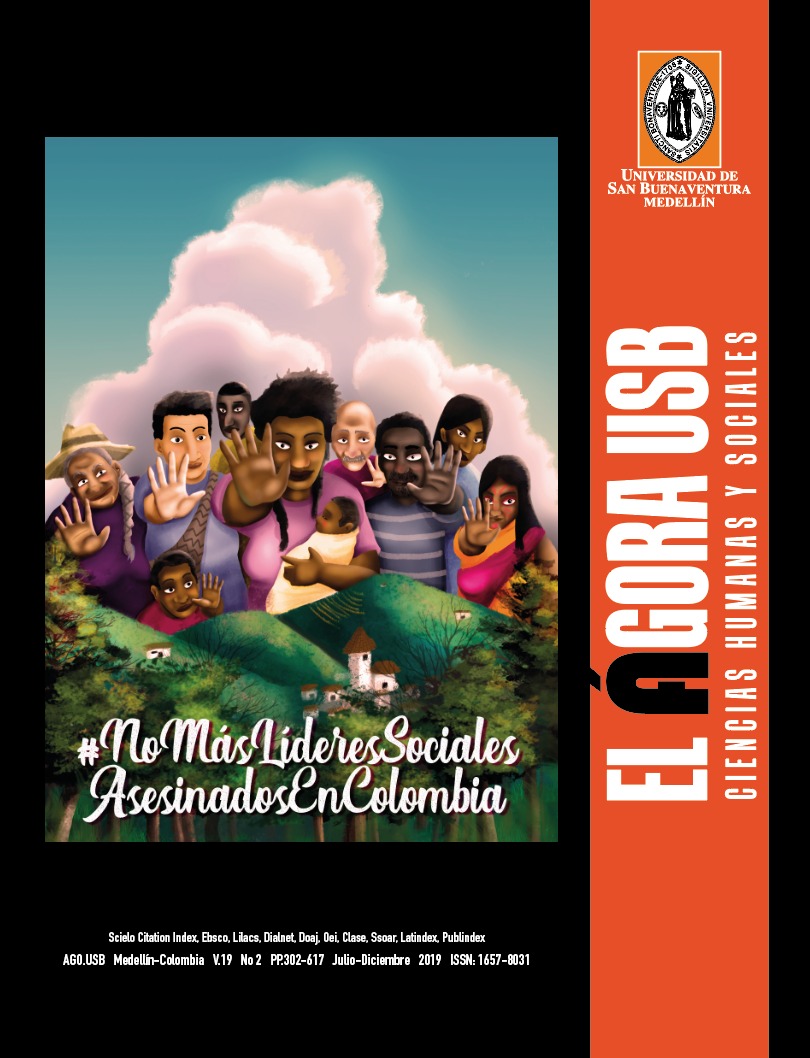The authors are also adhere to the creative commons license 4.0 (https://creativecommons.org/licenses/by-nc-nd/4.0/deed.es)
Attribution - NonCommercial - SinDerivar 4.0 International (CC BY - NC - ND 4.0)
Abstract
In order to achieve a sustainable peace over time, it is necessary to recognize
the symbolic dimension of violence and the ways in which it is
a guideline for the ethical and moral formation of subjects. Recognition
of these sequels allows us to design pedagogical strategies aimed at
creating a social ecosystem, which supports peace, namely, a political
community capable of understanding social realities outside the parameters
of violence.
References
Barry, A; Thomas O. y Nikolas R. (1996). Foucault and Political Reason: Liberalism, Neo-Liberalism
and Rationalities of Government. Chicago: University of Chicago Press.
Castillejo, A. (2000). Poética de lo otro: Hacia una antropología de la guerra, la soledad y el
exilio interno en Colombia. Bogotá: Universidad de los Andes
Comisión de la Verdad y Reconciliación del Perú, CVR. (2003). Informe Final. Lima: Comisión
de la Verdad y Reconciliación.
Das, V. y Kleinman, A. (2000). Violence and Subjectivity. Los Angeles: University of California
Press.
Degregori, C. (1990). Ayacucho 1969-1979: el surgimiento de Sendero Luminoso. Lima:
Instituto de Estudios Peruanos.
Espinosa, N. (2010). Política de vida y muerte. Etnografía de la violencia de la vida diaria en
la Macarena. Bogotá: ICANH.
Edel, M y Edel, A. (1959). Anthropology of Ethics: The Quest for Moral Understanding. Nueva
Jersey: Transaction Publishers.
Evans- Pritchard, E. (1968). Witchcraft, Oracles and Magic Among the Azande. Londres:
Oxford University Press.
Fassin, D. (2012). Humanitarian Reason. A Moral History of the Present. Los Ángeles: University
of California Press.
Foucault, M. (1996). Tecnologias del yo y otros textos afines. Barcelona: Paidós.
Green, L. (2011). The Utter normalization of Violence: silence, Memory and impunity among
the Yup’ik People of southwestern Alaska. En: Maria Six- Hohenbalken and Nerina
Weiss. Eds. Violence Expressed: An Anthropological perspective
Hass, J. (2012). Markets, Moral Economies and Cultural Contradictions of Post-Socialist
Russia. Nueva York: Palgrave Macmillan.
Jimeno, M. (2003). Elementos para un debate sobre la comprensión de la violencia. Cuadernos
del CES. Universidad Nacional de Colombia
Lambek, M. (1996). The Past Imperfect: Remembering as Moral Practice. En: Paul Antze y
Michael Lambek (Eds) Tense Past: Cultural Essays in Trauma and Memory. Nueva
York: Routledge
Lutz, C y White, G. (1986). The Anthropology of Emotions. Annual Review of Anthropology,
15, pp. 405-436.
Malinowski, B. (1926). Crime and Custom in Savage Society. Londres: Paul Kegan.
Marrett, R. (1914). The Threshold of Religion. Londres: Methuen.
Marín, K. (2017). Construcción de paz en escenarios de violencia intracomunitaria. Estudio
de caso Sierra de la Macarena (Meta- Colombia). Estudios Políticos, 51, pp. 196-217
Nussbaum, M. (2014). Emociones políticas ¿por qué el amor es importante para la justicia?
Barcelona: Paidós.
Ochs, E. (2012). Experiencing Language. Anthropological Theory, (12) 2: 142-160.
Read, K. (1965). The High Valley. Nueva York: Columbia University Press.
Rigliciano, R. (09 de junio de 2018). La construcción de paz puede tomar tanto tiempo
como la guerra. El Espectador. Recuperado de: https://colombia2020.elespectador.
com/pais/la-construccion-de-paz-puede-tomar-tanto-tiempo-como-la-guerra-robert-ricigliano
Robben, A. (2008) Response to Nancy Scheper-Hughes. Social Anthropology/Anthropologie
Sociale: 16 (1), pp. 77–89.
Santos, B. (1991). Estado, derecho y luchas sociales. Bogotá: Editorial ILSA.
Scheper- Hughes, N; Bourgois, P. (2004) Violence in war and peace: an anthology. Cambridge:
Blackwell
Theidon, K. (2000). “How we learned to kill our brother?” Memory, morality and reconciliation
in Peru. Bulletin de institut français d études andines, (29) 3: 539-554
Theidon, K. (2004). Entre prójimos. El conflicto armado interno y la política de reconciliación
en el Perú. Lima: Instituto de Estudios Peruanos.
Ulfe, Y. (2013). ¿y después de la violencia que queda? Víctimas, ciudadanos y reparaciones
en el contexto post-CVR en el Perú. Buenos Aires: CLACSO.
Yurchak, A. (2006). Everything Was Forever Until It Was No More: The Last Soviet Generation.
Princeton: Princeton University Press.
Zigon, J. (2010). Making the New Post- Soviet Person: Moral Experience in Contemporary
Moscow. Leiden: Brill
Zigon, J. (2009). Morality and Personal Experience: The Moral Conceptions of a Muscovite
Man. Ethnos, (37) 1: 78-101




















